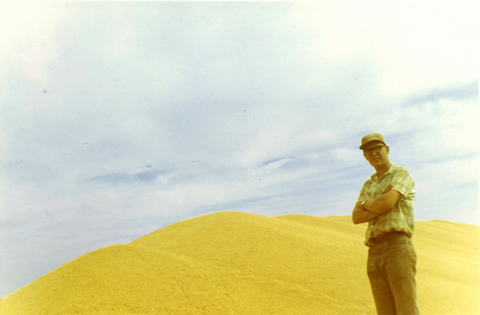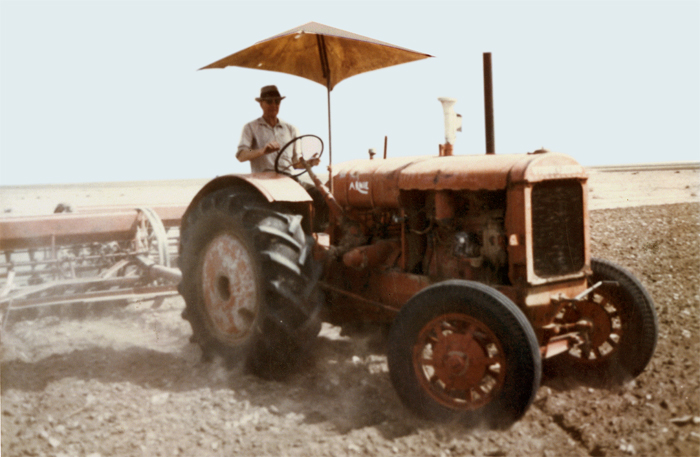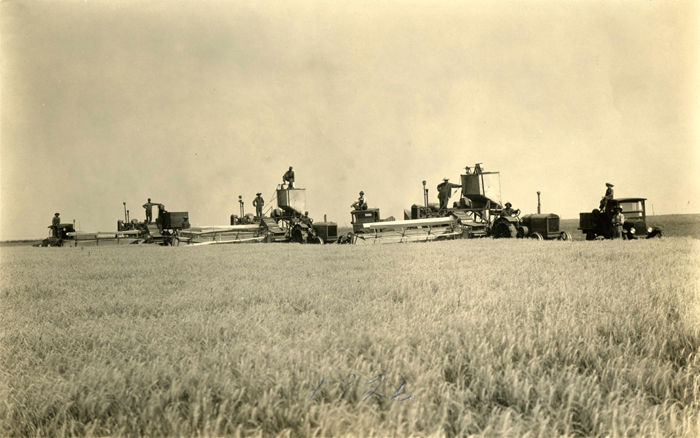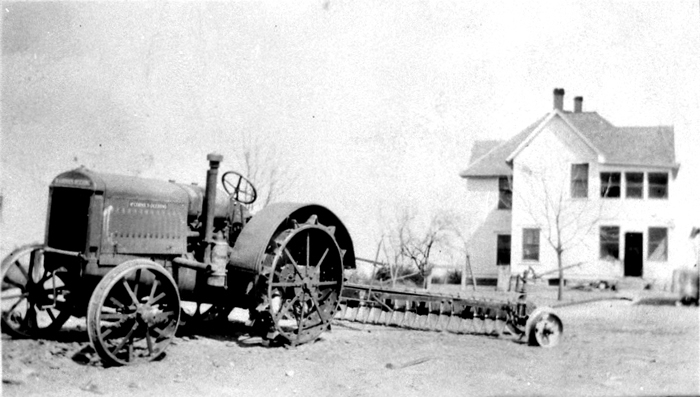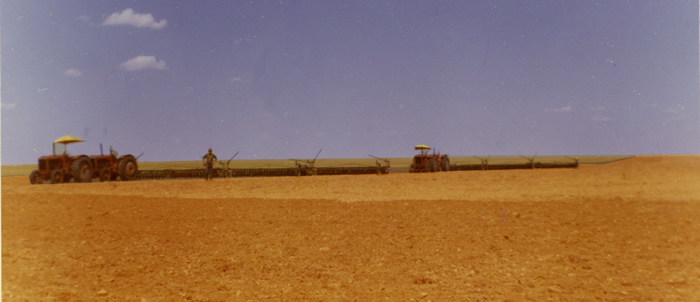
McCormick-Deering 15-30/22-36:
The Faithful Old 15-30
by Kevin Stephenson
Originally published in
Gas Engine Magazine
Volume 20, Jan/Feb 1985
Kevin Stephenson is a senior contributor to McCormick-Deering.com and has written a number of
articles in past years for "Gas Engine Magazine". With Kevin's permission, we are pleased to be able
to offer these articles for you to enjoy. The Faithful Old 15-30 is the second in the series.
From your friends at McCormick-Deering.com
Gas Engine Magazine has told the stories of many farmers' recollections of farming and the machines they used back in the "good old days". This story is about a farmer who carried the good old days into the present with him, and made it pay off. It is a tribute to a Kansas farmer named Ralph Burnett and to the machines he used to make his living, machines which are now being collected and restored by readers of GEM.
Ralph Burnett drilling wheat - Syracuse, KS 1972 Tractor is a 1929 Model 15-30 on rubber
Ralph Burnett and Farming
On July 18, 1979 , a south-central Kansas farmer named Ralph Burnett died of cancer in a hospital at Greensburg , Kansas. He was well known throughout the area for being a highly successful farmer-stockman, a friend and good neighbor, and an avid basketball fan. But it was something else that he did that marked him as an unusual individual. He had the ability to make his farm enterprise show a very respectable profit when other area farmers were feeling the effects of low farm prices. This fact in itself isn't as unusual as his method. When he died in July of 1979, a farm tractor that he bought new in 1929 was still in service on his farm!
Ralph Burnett grew up on a sand-hill farm northeast of Mullinville, Kansas. As a boy, he and his brothers worked their sandhill ground with horses, listers, sleds, raised their own feed, and made their own fun.
At the age of 20, in 1923, he married Ethel Rudd, the daughter of prominent area farmer-stockman Arthur Rudd, and settled on a little farm southeast of Mullinville. The farm was owned by Ethel's parents, and it was here that Ralph put in his first crop on his own.
The 1923 crop was pretty good, but it took a long time to harvest and work the ground with horses. Ralph was still working ground in November of 1924, when one of his neighbors stopped by and remarked, "Ralph, the snow's going to catch you in that field!" It almost did, as he was 30 days plowing 320 acres with a team of horses. There had to be a better way!
In the summer of 1925, Ralph went to the International Harvester dealer in Mullinville , Kansas , W.H. Culley 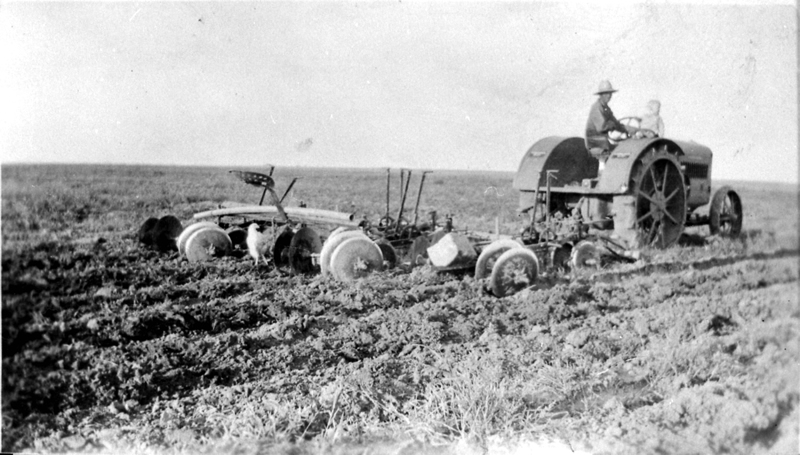 Hardware,
and looked over a new shipment of tractors they had just received. Not looking forward to another long season of field work,
Ralph bought his first tractor, a 1925 McCormick-Deering 15-30.
Hardware,
and looked over a new shipment of tractors they had just received. Not looking forward to another long season of field work,
Ralph bought his first tractor, a 1925 McCormick-Deering 15-30.
First day on the farm - 1925 Model 15-30
The new 15-30 had 5-inch spade lugs, and was equipped with an Ensign JTW kerosene carburetor with water mixer. It looked
pretty sharp with its dark gray finish and bright red wheels. Ralph roaded it out to the farm, and put it to work in front of
a horse-drawn tandem-disc. Ralph was so proud of his new tractor that he had Ethel take some pictures of it as he finished a
field, with his one-year-old son Virgil on the seat with him.
1925 was a good year for the Burnetts, but 1926 was even better. The 1926 harvest was a busy one, but there was plenty of help and machinery. Ralph and his father-in-law, A.E. Rudd, and his brother-in-law, Homer Rudd, harvested the crop with the help of a neighbor, Hode Ralstin, and their machines covered a lot of ground. There were three McCormick-Deering pull-type combines pulled by three 15-30's.
1926 Harvest - Model 15-30's and Pull-type Combines
1925 Model 15-30 at the Rudd Farm
After harvest, Ralph and Ethel took their son and went on an automobile trip to Niagra Falls with Ethel's parents.
Trading Up In Tractors
The farm was really prospering, so in 1927 Ralph traded the tractor in on a new 1927 model 15-30. The '25 had started to use a little oil, and was, for some reason, getting oil into the water (? ), so he traded it to avoid an overhaul bill.
The '27 15-30 had clamp-on rear steel wheels, and an Ensign model RW 1 1 /4-inch kerosene carburetor with a water-injection attachment. This tractor worked the Burnett farm in 1927 and 28. Ralph and Ethel moved to the big A.E. Rudd homestead in 1928, and the farming began to expand.
In the fall of 1929, Ralph decided it was time to trade tractors again. International Harvester had brought out a modified version of the famous 15-30, with increased horsepower, bigger engine bore, and a new combination-type kerosene/gasoline manifold.
(continued at top right column)
Ralph looked over the tractors on Culley's lot, and when he found the one he wanted, he marked it by putting three scratches in the paint on the right rear fender. The deal was made with an agreed-on price of $1250.00.
A day or two later, Ralph apparently got cold feet, and told Wayne Culley he'd have to wait awhile to buy a new tractor. The stock market had just crashed, and people were wondering about the future. Ralph and Ethel were expecting their fourth child.
The child, a girl, was born in January of 1930, and in the spring Ralph decided conditions were stable enough that he could buy his new tractor.
He went back to Culley's, and Wayne told him he had some carry-over 1929's in stock. Ralph looked over the machines, and when he found one with three scratches in the paint on the right rear fender, he bought it. The dealer took a $50.00 reduction in the price, so he got it for $1200 less his trade.
The 1929 Model 22-36 Arrives
This tractor was called a 15-30 by IHC, to continue uninterrupted the fine record of the 15-30, but the actual horsepower rating, confirmed in the Nebraska test of 1929, was 22 drawbar and 36 brake horsepower. In later years, it was the farmers themselves who referred to this tractor as a "22-36", and the name stuck. IH then began to refer to it this way in its publications.
Working Hard To Make It
This tractor was to become the workhorse of the Burnett farm, as the Great Depression hit Kiowa county in mid-1931. Ralph got a job dragging roads with his tractor, and hauled sand for the WPA. He drove a school bus, and helped at Culley's hardware to help support his family. The depression deepened, and everyone did their best to make ends meet. Some were more successful than others.
International Harvester couldn't collect debts that most farmers owed on tractors and machinery, and Ralph Burnett was no exception. The company offered to cancel the balance of the debt if Ralph could pay half of it, so he borrowed the money and paid IHC $200.00. His tractor ended up costing only $800.00.
Farmer Engineered Improvements
Ralph couldn't afford to trade tractors, so he started making improvements on his. He found out he could boost the horsepower by installing an overhead exhaust, straight-gasoline manifold and Zenith K5 carburetor, so this was done in 1934. The manifold and carburetor were designed for the P-300 power unit. He also put in a variable-speed P-300 governor, to get better load-handling from the engine.
In 1935, he hired a local blacksmith to cut the spokes on the steel wheels and install rubber tire rims; he was one of thousands of farmers to do this. On November 1, 1936, International Harvester company changed the paint scheme on their tractors from the traditional gray with red wheels to all red, for safety reasons, because of the poor road visibility of the gray paint. Ralph Burnett and his neighbors followed suit, and painted their tractors IH red. This is why so many of these early tractors are painted red today.
The old 15-30 continued to be used on the Burnett farm, for everything from plowing to grinding feed, and might have been traded off but for one problem: World War II. Ralph's sons went to the military, and the tractor manufacturers were busy building war materials, so the "Faithful Old 15-30" continued to work the family farm. Ralph once calculated that in the period from 1940-1950, his tractor among all its other chores; bound ten thousand acres of feed for him and his neighbors.
The "Double-Header"
In 1953, Ralph rented some ground in Hamilton County, Kansas, from a Greensburg landowner, and started trucking his tractor back and forth to do the farm work. This got to be a lot of trouble, so he began looking for another tractor to buy. One of his neighbors traded in a late 15-30 on a W-9, so Ralph bought it. Some time thereafter he got the idea to couple two of these tractors together, into what he called a "double-header". With the engine modifications made and the two tractors coupled together, the combined unit developed 130 horsepower. A double-header was capable of pulling three fifteen-foot oneway plows at a depth of 6-8 inches at 4 1/2 MPH. This performance was quite comparable to a neighbor's 4020 John Deere.
Double Headers - 3 One-way Plows Each
As Ralph's grandchildren became old enough to help on the farm, Ralph continued to buy used "22-36's" as they were traded in, and eventually he owned FIFTEEN of these tractors, twelve of which were in operating condition. In order to distinguish one tractor from another, Ralph named each one after its previous owner, and painted the name on the gas tank. Three generations of Ralph Burnett's family farmed with these machines. The use of these old tractors and the old equipment didn't hurt his production any, as evidenced by the harvest pictures. The 1970 crop averaged 53 bushels per acre dryland.
The End of an Era
Ralph's wife Ethel died in 1972, and Kevin Stephenson, the last grandson, got married in 1973, but he continued to help with the farm work part-time in the summer. The farm continued to prosper, and the old tractors continued to run.
Just before Ralph died in 1979, he gave Kevin Stephenson three of the old "22-36's" in exchange for his labor from that summer, as Ralph had been in the hospital and couldn't do the work.
The tractor on the cover of this issue is a 1932 McCormick-Deering 15-30
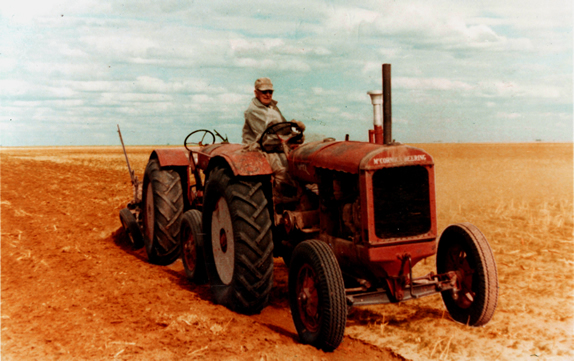 of the increased horsepower, or "22-36"
design. It was restored by Kevin Stephenson over a sixteen month period in 1982 and 83. Serial number of this unit is
TG-155156-MB. This tractor was purchased from a neighbor by Ralph Burnett in 1968 for $35.00. Kevin farmed with this
tractor from 1968 to 1979. This particular tractor had a ball-bearing transmission, as well as the ball bearing mains in
the engine for which McCormick-Deering tractors were famous. This tractor has appeared at the threshing show at Haviland,
Kansas several times, and the Mullinville Kansas Centennial Celebration on Labor Day weekend, 1984.
of the increased horsepower, or "22-36"
design. It was restored by Kevin Stephenson over a sixteen month period in 1982 and 83. Serial number of this unit is
TG-155156-MB. This tractor was purchased from a neighbor by Ralph Burnett in 1968 for $35.00. Kevin farmed with this
tractor from 1968 to 1979. This particular tractor had a ball-bearing transmission, as well as the ball bearing mains in
the engine for which McCormick-Deering tractors were famous. This tractor has appeared at the threshing show at Haviland,
Kansas several times, and the Mullinville Kansas Centennial Celebration on Labor Day weekend, 1984.
